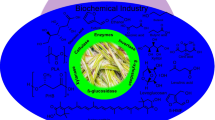Abstract
Bagasse of Agave tequilana (BAT) is the residual lignocellulosic waste that remains from tequila production. In this study we characterized the chemical composition of BAT, which was further saccharified and fermented to produce ethanol. BAT was constituted by cellulose (42%), hemicellulose (20%), lignin (15%), and other (23%). Saccharification of BAT was carried out at 147°C with 2% sulfuric acid for 15 min, yielding 25.8 g/l of fermentable sugars, corresponding to 36.1% of saccharificable material (cellulose and hemicellulose contents, w/w). The remaining lignocellulosic material was further hydrolyzed by commercial enzymes, ~8.2% of BAT load was incubated for 72 h at 40°C rendering 41 g/l of fermentable sugars corresponding to 73.6% of the saccharificable material (w/w). Mathematic surface response analysis of the acid and enzymatic BAT hydrolysis was used for process optimization. The results showed a satisfactory correlation (R 2 = 0.90) between the obtained and predicted responses. The native yeast Pichia caribbica UM-5 was used to ferment sugar liquors from both acid and enzymatic hydrolysis to ethanol yielding 50 and 87%, respectively. The final optimized process generated 8.99 g ethanol/50 g of BAT, corresponding to an overall 56.75% of theoretical ethanol (w/w). Thus, BAT may be employed as a lignocellulosic raw material for bioethanol production and can contribute to BAT residue elimination from environment.




Similar content being viewed by others
References
Lynd L, van Zyl W, McBride J, Laser M (2005) Consolidated bioprocessing of cellulosic biomass: an update. Curr Opin Biotechnol 16:577–583
Cedeño-Cruz M (2003). Tequila production from agave; historical influences and contemporary processes. The alcohol textbook. 4th edn. Nottingham University Press, pp 223–245
Hernández-Salas JM, Villa-Ramírez MS, Veloz-Rendón JS, Rivera-Hernández KN, González-César RA, Plascencia-Espinosa MA, Trejo-Estrada SR (2009) Comparative hydrolysis and fermentation of sugarcane and agave bagasse. Biores Technol 100:1238–1245
Zhao H, Jones CL, Baker GA, Xia S, Olubajo O, Person VN (2009) Regenerating cellulose from ionic liquids for an accelerated enzymatic hydrolysis. J Biotechnol 139:47–54
Ruiz E, Cara C, Manzanares P, Ballesteros M, Castro E (2008) Evaluation of steam explosion pre-treatment for enzymatic hydrolysis of sunflower stalks. Enzyme Microbiol Technol 42:160–166
Martin C, Galbe M, Nilvebrant NO, Jonsson LJ (2002) Comparison of the fermentability of enzymatic hydrolysates of sugarcane bagasse pretreated by steam explosion using different impregnating agents. Appl Biochem Biotechnol 98:699–716
Kaar WE, Holtzapple MT (1998) Benefits from Tween during enzymatic hydrolysis of corn stover. Biotechnol Bioeng 59:419
Prior BA, Day DF (2008) Hydrolysis of ammonia-pretreated sugar cane bagasse with cellulase, β-glucosidase, and hemicellulase preparations. Appl Biochem Biotechnol 146:151–164
Zhang YH, Lynd LR (2004) Toward an aggregated understanding of enzymatic hydrolysis of cellulose: noncomplexed cellulase systems. Biotechnol Bioeng 88:797–824
Messner R, Kubicek CP (1991) Carbon source control of cellobiohydrolase I and II formation by Trichoderma reesei. Appl Environ Microbiol 57:630–635
Saloheimo M, Kuja-Panula J, Penttila M (2002) Enzymatic properties and intracellular localization of the novel Trichoderma reesei β-glucosidase BGLII (Cel1A). Appl Environ Microbiol 68:4546–4553
Rosgaard L, Andric P, Dam-Johansen K, Pedersen S, Meyer AS (2007) Effects of substrate loading on enzymatic hydrolysis and viscosity of pretreated barley straw. Appl Biochem Biotechnol 143:27–40
Sung Y, Cheng J (2002) Hydrolysis of lignocellulosic materials for ethanol production: a review. Biores Technol 83:1–11
k i, Chen X, Shen F, Su Y, Wan Y (2009) Optimization of enzymatic hydrolysis of wheat straw pretreated by alkaline peroxide using response surface methodology. Ind Eng Chem Res 48:7346–7353
Bozell JJ, Moens L, Elliott DC, Wang Y, Neuenscwander GG, Fitzpatrick SW, Bilski RJ, Jarnefeld JL (2000) Production of levulinic acid and use as a platform chemical for derived products. Res Conserv Recycl 28:227–239
Matsushika A, Watanabe S, Kodaki T, Makino K, Sawayama S (2008) Bioethanol production from xylose by recombinant Saccharomyces cerevisiae. J Biosci Bioeng 105:296–299
Stephanopoulos G (2007) Challenges in engineering microbes for biofuel production. Science 315:801
Okuda N, Ninomiya K, Katakura Y, Shioya S (2008) Reducing supplemental medium cost in bioethanol production from waste house wood hydrolysate by ethanologenic Escherichia coli: inoculum size increase and coculture with Saccharomyces cerevisiae. J Biosci Bioeng 105:90–96
Browning BL (1967) Methods of wood chemistry. Wiley, New York
Shleser R (1994) Ethanol production in Hawaii. State of Hawaii. Department of Business, Economic Development and Tourism. Energy Division, Honolulu
Öhgren K, Bengtsson O, Gorwa-Grauslund MF, Galbe M, Hahn-Hägerdal B, Zacchi G (2006) Simultaneous saccharification and co-fermentation of glucose and xylose in steam-pretreated corn stover at high fiber content with Saccharomyces cerevisiae. J Biotechnol 126:488–498
Olofsson K, Rudolf A, Lidén G (2008) Designing simultaneous saccharification and fermentation for improved xylose conversion by a recombinant strain of Saccharomyces cerevisiae. J Biotechnol 134:112–120
Rudolf A, Baudel H, Zacchi G, Hahn-Hägerdal B, Lidén G (2008) Simultaneous saccharification and fermentation of steam-pretreated bagasse using Saccharomyces cerevisiae TMB3400 and Pichia stipitis CBS6054. Biotechnol Bioeng 99:783–790
Wahlbom CF, van Zyl WH, Jönsson LJ, Hahn-Hägerdal B, Otero RR (2003) Generation of the improved recombinant xylose-utilizing Saccharomyces cerevisiae TMB 3400 by random mutagenesis and physiological comparison with Pichia stipitis CBS6054. FEMS Yeast Res 3:319–326
Neirinck LG, Maleszka R, Schneider H (1984) The requirement of oxygen for incorporation of carbon from d-xylose and d-glucose by Pachysolen tannophilus. Arch Biochem Biophys 228:13–21
Millati R, Sues A, Edebo L, Taherzadeh M (2005) Ethanol production from hexoses, pentoses, and dilute-acid hydrolyzate by Mucor indicus. FEMS Yeast Res 5:669–676
Acknowledgments
This research was funded by CONACYT, COECYT, and C.I.C./UMSNH grants. We thank Gustavo Pacheco for comments during the manuscript preparation.
Author information
Authors and Affiliations
Corresponding author
Electronic supplementary material
Below is the link to the electronic supplementary material.
Rights and permissions
About this article
Cite this article
Saucedo-Luna, J., Castro-Montoya, A.J., Martinez-Pacheco, M.M. et al. Efficient chemical and enzymatic saccharification of the lignocellulosic residue from Agave tequilana bagasse to produce ethanol by Pichia caribbica . J Ind Microbiol Biotechnol 38, 725–732 (2011). https://doi.org/10.1007/s10295-010-0853-z
Received:
Accepted:
Published:
Issue Date:
DOI: https://doi.org/10.1007/s10295-010-0853-z




